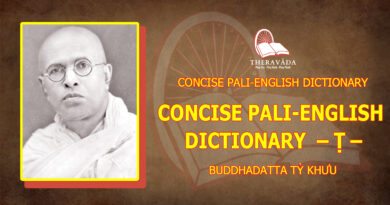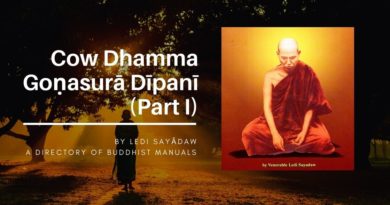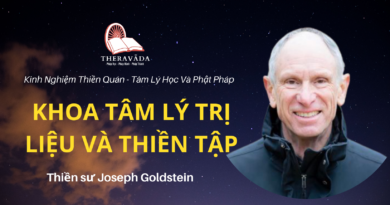SPIRITUAL FRIENDSHIP
SPIRITUAL FRIENDSHIP
A sunday afternoon talk given by Ajahn Amaro at Amaravati Buddhist Monastery; 19th September, 1993
In some of the Theravada countries the tradition of forest monasticism still flourishes. This style of practice, going off and living in the countryside, finding solitude and meditating alone in the wilds, is very often praised. Our teacher, Ajahn Chah, practiced in this way for many years. But in the latter part of his life, after spending a long time travelling, meditating and living alone, he integrated practice and teaching into the creation of a spiritual community.
He had found that he could develop profound concentration and insight, and experienced some interesting mind states when he went off into the hills alone, but then when he would come back and stay with the other monks, he could only cope for a little while. He would begin to lose his temper and get upset, angry and annoyed about how incompetent and useless everybody else was. After a few years of this, he realised that he had some lessons to learn: ‘Well, it is easy for me to go and be alone and be the fierce ascetic off in the forest. What is difficult is to be with other people, to learn how to spend time with others.’ So he began to put himself in that position more and more, and eventually he developed his monasteries in that style.
Often his monasteries were criticized because the monks and nuns seemed to have so little time to meditate. They were always working, and people seemed to have to spend so much time together: chanting together, meditating together. Many complained that this was an obstruction. He listened and understood the criticism but was never intimidated by it. He saw that there were profound lessons and great richness in learning to live together with other people.
In fact, it is the spiritual community or spiritual friendship that really holds the spiritual life together. It is interesting that of all the meditation masters in Thailand (not that one is keeping score), Ajahn Chah managed to establish far more monasteries than any other meditation teacher – all in all about 130-140. So it really works for ordinary human beings. We realise that to develop in the spiritual life, we need the support of companions; without that, we tend to drift or sink.
There is a very often-quoted saying in the scriptures on spiritual friendship. One day Ananda, his closest disciple, came up to the Buddha and said: ‘Lord, I think that half of the of the Holy Life is spiritual friendship, association with the Lovely.’ And the Buddha replied: ‘That’s not so; say not so, Ananda. It is not half of the Holy Life, it is the whole of the Holy Life.
The entire Holy Life is friendship, association with the Lovely.’ Now, the Pali word for ‘friendship with the Lovely’ is kalyanamitta. ‘Kalyana’ means ‘lovely’ or beautiful and ‘mitta’ means ‘friend’. So it is often translated as association or affiliation with the Lovely (with a capital L), being an epithet for Ultimate Reality or the Unconditioned.
It is interesting that for years I always used to quote it as: ‘Spiritual friendship is the whole of the Holy Life’, but the Buddha was making a play on words – he was also saying that it is not just having spiritual friends that is the whole of the Holy Life, but our affiliation, our intimacy with the Lovely, with the Ultimate Truth. These two support each other. Our like-minded companions and associates in spiritual life support our effort, but it is actually our ability to awaken to that which is truly Lovely, to the Wonderful, to Ultimate Reality – that is, in its own way, the very fire of our spiritual life.
When we say ‘spiritual friendship’, do we just mean the kind of people we meet in Buddhist monasteries? Does the spiritual friend have to have a shaven head? Or could it also be our husband, our wife, our life’s companion? There are many different kinds of relationship or friendship that we can have. So we might wonder which ones are spiritual and which ones are not. Can a romantic friendship be spiritual? Or does spiritual friendship have to be platonic? Can it be a relationship of teacher to student, or of brother and sister? Rather than categorising it in these ways, or trying to figure out which styles of friendship are spiritual and which are not, it is much more important to look at the basis of that relationship and our approach towards it. Relationships, I would suggest, fall into two basic categories. In one kind of relationship we tend to relate to the other person with a sense of separateness, in the other we relate with a sense of wholeness.
The relationship of separateness hinges on a profound sense of ‘me’ and ‘you’, of ‘self’ and ‘other’, and that is something very concrete, solid. We always look to the other person to fulfil a need that we have, due to a feeling of something lacking in ourselves; and that other person seems to fill that space. So this kind of relationship or friendship has a quality of dependency in it. We need the other person to be around in order to support us, to make us feel good; or we may even need to have the other person around to be an enemy – a good protagonist that we can struggle with!
We may have a very intense, profound relationship when we’re in love with someone and we experience very blissful times, a sense of wholeness or completeness. But these times also entail feelings of desolation and loss, of loneliness and separation. Even a strong friendship, such as with a teacher or a helper with whom we meditate or share a profound understanding of each other’s innermost world, may disappoint us in this way. As long as that relationship is based on a sense of ‘me’ and a sense of ‘you’, and that polarity is not recognised, there will always be pain and loss in it.
An incident is described in the scriptures when Visakha goes to the Lord Buddha one morning, having just come from the funeral for one of her grandchildren. Visakha was one of the Buddha’s great disciples. She had ten sons and ten daughters, and each of those had ten sons and ten daughters. So she was surrounded by an ocean of grandchildren, and she adored them. The Lord Buddha saw that her hair and her clothes were all wet, and he asked her why.
‘Lord, a dear and beloved grandchild of mine has died, that is why I have come here in broad day with my clothes and hair all wet.’
‘Visakha, would you like to have as many children and grandchildren as there are people in the whole city of Savatthi?’ (the local capital)
‘Yes indeed, Lord.’ She replied.
‘But Visakha, how many people die each day in Savatthi?’
‘Ten people die in a day in Savatthi, Lord, or nine or eight…or three or two or at least one. Savatthi is never without people dying.’
‘Then what do you think, Visakha, if you had as many children and grandchildren as there are people in Savatthi, you would be attending funerals for your offspring every day. Would you ever be with your clothes and hair not wet?’
‘No Lord – enough of so many children and grandchildren for me!’
Then he said: ‘Those who have a hundred dear ones have a hundred pains..’ (Udana VIII 8)
The ones who are dear to us, that attachment that we have towards them, this is beautiful and lovely but it also brings us pain. It carries a sting with it, a shadow, and this is unavoidable. If we invest in the delight of such association then, when there is separation, we cannot avoid feeling loss. So, a spiritual friendship of this type will always have this slightly unbalanced quality to it.
Now, on the other side, what I like to call a relationship of wholeness, is where our association with another person is based not around the sense of self at all. Instead, it is based on an attitude of relinquishment, of unselfishness; of openness rather than neediness.
This can be consciously developed in various ways. One such way is through devotional practice towards an idealised figure, such as Buddha, God, Jesus, Krishna or whoever it might be; or some living person, such as a guru. That act of self-relinquishment, of giving oneself in devotion to a divine figure, works by the power of one’s faith in the divinity of the person and their presence. This forms an important bond between oneself and the other. By giving oneself up completely to the Divine, whether it is internal or external, whether we create an object for it or we relate to a person who exhibits divine qualities, we can bring about a truly spiritual relationship. As the mind opens to that, we begin to internalise the qualities that they embody. We develop an inner joy and release from within our own being, without creating a state of unwholesome dependence.
Last weekend we had a conference of contemplatives here, with many Christian nuns and monks of different orders, as well as some Hindus and Sufis attending. It was interesting talking with them because, whereas Buddhists are quite unusual in practising a non-theistic religion, most other traditions have a very strong God-figure that occupies the focus of their attention. The whole manner of their prayers, liturgy and religious expression is created around devotion to God; giving yourself to God, praying to God, or giving up your heart to Jesus, Mary or Krishna.
It was apparent that the more you practise in this way the more you see Krishna or God, not only on the outside, but also on the inside. You begin to find yourself through this process of self-relinquishment in a complete, pure identification with that divine figure. In Sufi mystical poetry they often refer to Ultimate Reality. Their traditional verses move back and forth between sounding like love-songs describing a passionate affair, and the relationship between the individual and the Divine. We can see in some of the Sufi poetry the whole process of spiritual practice ends up with the realisation that we ourselves are ‘The Beloved’. There never was any real difference or separation between myself, as an apparent individual, and the Divine or God or Ultimate Reality.
The other way of developing this relationship of wholeness is through the path of meditation and wisdom. Using this approach, we become more aware of how we create the sense of ‘self’. By letting go very directly of the sense of ‘I’ and ‘me’ and ‘mine’ in our daily activity, we engage in a process of self-relinquishment, without any external object, being or deity to empower or to strengthen us. Just by inquiry, contemplation and insight – using the power of the mind – we break through the sense of ‘self’, allowing the mind and the heart to be fully opened to the Truth.
A friendship or relationship that is developed in this way brings with it a freedom from dukkha – incompleteness and dissatisfaction. If we relate in this way, letting go of ‘self’ and dropping the feeling of ‘I’ and ‘me’ and ‘mine’, the experience of being together is one of delight, of pleasantness, rather than neediness. There is no sense of insecurity, alienation or loneliness in the relationship and so there is a tremendous freedom. We can enjoy each other’s company and be supported by each other, but we are not requiring it. It is the same in a spiritual training, where we must be careful not to become dependent on the teacher; likewise, a true teacher will not need the admiration or attention of their students.
There is a whole culture nowadays of blaming our problems in life on our ‘dysfunctional’ family or on a dysfunctional relationship. We can find ourselves locked into a relationship where we can neither love the other person, nor can we leave them. We are, to use another current term, ‘co-dependent’. The relationship is very destructive: we can’t live with them, and we can’t live without them.
If we try to establish a spiritual friendship without any real understanding of spiritual beauty, or Truth, then it will always end up being dysfunctional and co-dependent; but if we try to live with an awareness of or an intimacy with Truth, without any spiritual companions or support, we very easily lose our way. Neither approach will bring good results. The two support each other and it is just this symbiosis that, ideally, the four-fold community of Buddhist disciples symbolises and embodies. Laymen, laywomen, nuns and monks, as spiritual community, can empower the opportunity for insight into Truth.
Even though many of us like to be alone, we can find it difficult to use such an opportunity fully. I often feel it is rather like Ajahn Chah’s experience: he liked to be alone, he could enjoy himself being off in the forest without anyone to bother him, but it was the monastic form within a community lifestyle that he used to train his monks and nuns. In community life spiritual maturity, that quality of true independence, is put to the test. Regardless of what the world throws at us, there has to be the effort to sustain an equilibrium; we have to open ourselves up to the points of view and feelings of others, and yet sustain an inner integrity, so that we don’t wobble, crumple or sink. I am always impressed by those who maintain their spiritual life and practice far away from other people. It takes tremendous strength to develop a real penetration of Truth, and there may only be a handful of people that can do it on their own without support.
Certainly, for myself, I deeply value coming across the Sangha. I started my vague attempts at spiritual practice as a teenager; by the time I was twenty-one I was in a profound mess. It was then that I visited a branch of this monastic community in Thailand. What really impressed me there was how powerful a presence that group of people had. Simply knowing on my own that it would be a good thing for me to meditate and practice yoga, or to stop drinking and smoking did not have the same impact in helping me to break my habits, and to resist the influence of social norms. I just did not have the clarity of mind to sustain a true and honest spiritual perspective. But suddenly, being in a place where people had given up all the things that I was trying to give up, and were doing all the things that I was trying to do, it felt rather like having been lost in the wilderness and then stepping onto a bus that was heading in the right direction. At last I did not have to struggle on my own.
From an idealistic position one could say: ‘It’s better to do it on your own; that’s the way to be strong.’ But for most of us it’s very easy to be fooled, to follow our own desires and fears and to be dishonest with ourselves. Living amongst like-minded people provides a great mirror to see our own preferences, our own fears and shortcomings.
One of the great blessings of giving oneself to a spiritual community, or even to a standard of spiritual teachings, is the objective measure we receive for the conditioning of our own mind; it is like watching the habits of the mind being projected onto a screen, rather than just following them around and never really seeing them. We are given the chance to stand back from them and to see what we always run away from, what we are always being pulled towards, what we seek as a place of comfort and safety, what makes us feel good or bad. That kind of objectivity enables us to stop being impressed by our thoughts or moods; once we can see things as they are, we are able to witness the movements of the mind and we are then able to transcend them.
This year I learnt the word, ‘schmoozing’, ‘to schmooze’; I think it is a Yiddish word. It means to hang out with your friends, and chat and drink tea, doing nothing very much, just having a good time together. To schmooze is a very admirable and useful activity, and I’m not being facetious here. It is amazing how often people who are interested in spiritual practice come to a centre like this monastery, and listen to a talk or do a retreat and, as soon as it is over, everyone goes home. Sometimes you go to Buddhist groups for years, and you find that the people in the group hardly know each other. But part of developing our spiritual life is to spend time with each other, to generate a sense of respect and gratitude for each other’s interests and commitment to spiritual values; not to just think: ‘The talk is over, now it’s time to go home.’ or, ‘The retreat is finished, now I’ll go off, I’ve got this and that to do.’
Through getting to know those who delight in the Buddha’s teaching we create a connection with them; we establish a support system. This is kalyanamitta, the network of spiritual friendship. This is what really enables us as a human society to hold together. Political agreements don’t work, laws don’t work; it is our ability to strengthen and affirm our qualities of inner beauty, of kindness and generosity, and to encourage those in others – that’s what enables human beings to live in a wholesome and profitable way.
In spiritual friendship, we can actually be with each other. We open ourselves to the other person, ready to notice any grudges that we have, or the opinions and obsessions we have about them, as well as the attractions towards them. Then we can enter more into the place of listening, of forgiving, of letting go of the past and just being open to the present. And this is the most wonderful and beautiful gift we can give.
Ajahn Amaro
Forest Sangha Newsletter, No. 41, July-September 1997, U.K.
Source: Budsas.org






